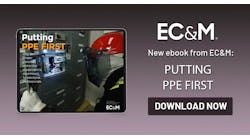Safety practices for the back are largely concerned with preventing acute and direct injury to the back. Yet, chronic or accumulated injuries can be just as debilitating and painful.
Worse, beyond a certain point, the damage is permanent. Treatment serves only to help you cope with the pain, loss of strength, and decreased range of motion. Prevention is paramount. It helps to look at prevention systematically. The first system we’ll look at is your neck.
Neck
Neck problems will cause compensation in other parts of the posterior chain, and back pain will inevitably result. The major cause of neck problems today is head-forward posture. Electricians have long been at risk for this due to craning over to perform tasks such as making connections. When you add to that addictive cell phone use, the risk skyrockets. The use of tablets and laptops for field testing further exacerbates this.
Some tips:
- Craning is unavoidable, so you must counter its effects. While involved in a craning activity, take a 10- or 15-second break periodically to “negative crane” — pull your head back in the other direction. Hold for a few seconds, then repeat.
- Reduce the need to crane. Set your device in a position that does not require you to look down at it or at least decreases the angle. For example, perhaps you can hang your digital multimeter on a cabinet door at a height that requires you to look slightly upward. When performing a test procedure that involves a laptop, can you place something under it to decrease the viewing angle and, thus, your neck-craning angle?
- Exercises. Set aside time each day to specifically perform neck exercises such as negative craning. You can find them with a quick search online for “head-forward exercise.” Schedule time with a recurring Outlook appointment or a similar calendar app.
Shoes
Your feet are the first shock absorbers in your posterior chain; anything out of whack there will create stress elsewhere.
Some tips:
- Strengthen your feet. Feet that are always in rigid shoes (the kind you need to work safely) do not get enough exercise. The 29 muscles associated with each foot can atrophy. Even going barefoot while at home might be enough to protect you, but it also helps to do foot-specific exercises. As with the neck exercises, you can find these online.
- Check your shoes. Sure, it’s a chunk of change to invest in good work shoes or boots. But don’t try to get every penny’s worth from that purchase. If the inner soles now feel hard or the outer soles are severely worn, discard the shoes.
- Check your shoe heels. If you have a correct gait, your heels will wear evenly. If your heels wear unevenly, see a podiatrist, chiropractor, or other qualified medical professionals for an evaluation.
- Change shoes daily. It takes a pair of shoes about 24 hours to recover from a day of use. If you have two or three pairs of work shoes, simply wear a different pair each day.
Legs
Tight hamstrings are weak hamstrings. That’s why stretching, while good, isn’t the solution to hamstring problems. Imbalance between the anterior (quadriceps) and posterior (hamstrings) muscles of the upper leg is common. And it’s a primary contributor to back pain.
The quads often get worked to lower you into a chair or rise out of it. But what do you do to strengthen those hamstrings and create balance in your legs? The tendency among many gym-goers to work only the muscles you can see in the mirror makes things worse. Certain kinds of exercises, such as leg presses, work the quads but fail to work the hamstrings.
So, you need to work your hamstrings. You can find a variety of body weight, free weight, and band-based exercises via an online search. Figure out what works for you and add it to your routine. If you don’t have a routine, you can choose between years of back pain or creating a routine. It does not need to be elaborate, and you do not need to buy any equipment.
Sitting
Sitting is unavoidable for many tasks. But sitting puts pressure on your disks while stretching some muscles the wrong way and tightening others for too long.
Your first line of defense is to sit up straight. Relatively few people do this, so you may not know what is meant. Look around at how people sit. Typically, that’s with shoulders hunched forward and the upper body sagging forward. The arch in their lower back is flattened or even curved in the opposite direction from normal. What you want to do instead is pull those shoulders back and adjust yourself so the natural arch in your lower back is there. Reach behind with the back of your hand, placing it in the small of your back just below where the big lat muscles end. If there’s no curve, you need to adjust your posture until the natural curve is restored.
Your second line of defense is don’t sit too long. Simply taking a five-second break to stand up from your chair and sit back down can help. Take a little longer to push your chest up and shoulders back as far as you can while arching your back, and you get even more relief.




